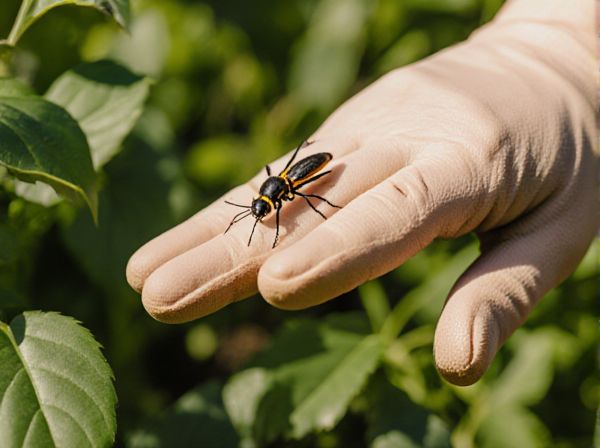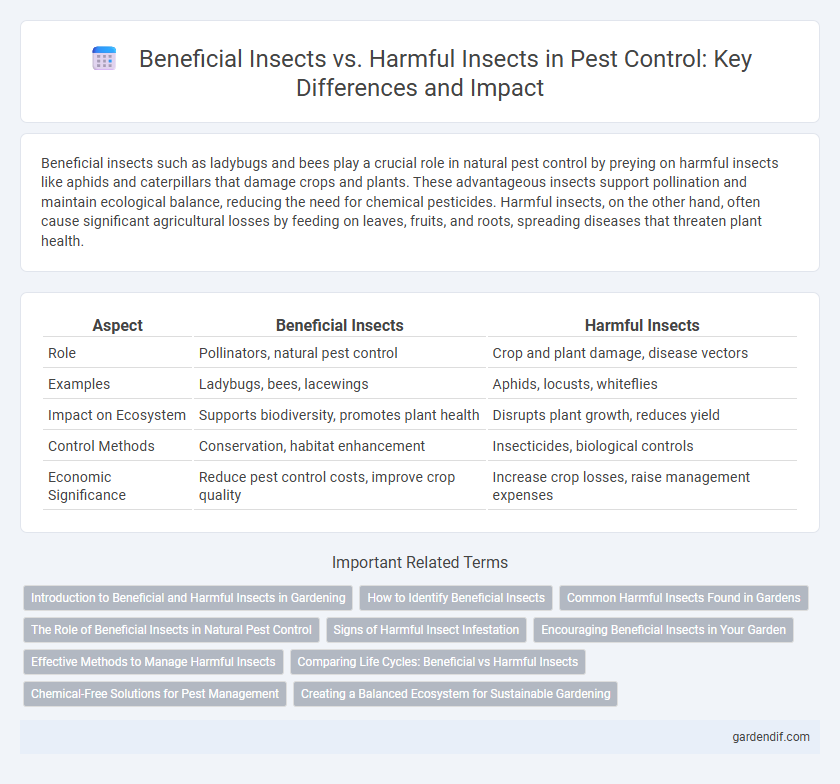
Beneficial insects vs Harmful insects Illustration
Beneficial insects such as ladybugs and bees play a crucial role in natural pest control by preying on harmful insects like aphids and caterpillars that damage crops and plants. These advantageous insects support pollination and maintain ecological balance, reducing the need for chemical pesticides. Harmful insects, on the other hand, often cause significant agricultural losses by feeding on leaves, fruits, and roots, spreading diseases that threaten plant health.
Table of Comparison
| Aspect | Beneficial Insects | Harmful Insects |
|---|---|---|
| Role | Pollinators, natural pest control | Crop and plant damage, disease vectors |
| Examples | Ladybugs, bees, lacewings | Aphids, locusts, whiteflies |
| Impact on Ecosystem | Supports biodiversity, promotes plant health | Disrupts plant growth, reduces yield |
| Control Methods | Conservation, habitat enhancement | Insecticides, biological controls |
| Economic Significance | Reduce pest control costs, improve crop quality | Increase crop losses, raise management expenses |
Introduction to Beneficial and Harmful Insects in Gardening
Beneficial insects such as ladybugs and predatory wasps play a crucial role in controlling harmful insect populations like aphids and caterpillars in gardening. These natural predators help maintain a balanced ecosystem, reducing the need for chemical pesticides while promoting healthy plant growth. Understanding the identification and behavior of both beneficial and harmful insects is essential for effective integrated pest management.
How to Identify Beneficial Insects
Beneficial insects can be identified by their role in pest control, such as ladybugs consuming aphids or predatory wasps targeting caterpillars. Their physical traits often include bright colors, segmented bodies, and distinctive wing patterns that differentiate them from harmful pests. Observing insect behavior in the garden helps pinpoint species that contribute to plant health by preying on or parasitizing harmful insects.
Common Harmful Insects Found in Gardens
Common harmful insects found in gardens include aphids, spider mites, and caterpillars, which damage plants by sucking sap or consuming leaves. Leafhoppers and whiteflies also spread plant diseases and reduce crop yields. Identifying these pests early is crucial for effective pest management and protecting garden health.
The Role of Beneficial Insects in Natural Pest Control
Beneficial insects such as ladybugs, lacewings, and parasitic wasps play a crucial role in natural pest control by preying on harmful insects like aphids, caterpillars, and whiteflies, thereby reducing the need for chemical pesticides. These predators and parasitoids enhance ecosystem health by maintaining pest populations below damaging thresholds. Promoting beneficial insect habitats through planting native vegetation and minimizing pesticide use supports sustainable pest management and agricultural productivity.
Signs of Harmful Insect Infestation
Wilting leaves, yellowing foliage, and irregular holes on plant surfaces are common signs of harmful insect infestation, indicating damage caused by pests like aphids, caterpillars, and whiteflies. Sticky residue or honeydew on leaves often signals the presence of sap-sucking insects such as scale insects or mealybugs. Monitoring these symptoms helps distinguish harmful pests from beneficial insects that support plant health through pollination and natural pest control.
Encouraging Beneficial Insects in Your Garden
Encouraging beneficial insects like ladybugs, lacewings, and parasitic wasps enhances natural pest control by targeting harmful insects such as aphids, caterpillars, and whiteflies. Planting nectar-rich flowers, maintaining diverse plant species, and minimizing pesticide use create an inviting habitat for these predators and pollinators. Utilizing companion planting and providing shelter through mulch or insect hotels further supports beneficial insect populations, promoting a balanced and healthy garden ecosystem.
Effective Methods to Manage Harmful Insects
Targeted use of biological control agents such as ladybugs and parasitic wasps effectively reduces harmful insect populations while preserving beneficial insects that promote plant health. Incorporating integrated pest management (IPM) strategies, including regular monitoring and selective pesticide application, minimizes collateral damage to beneficial species. Implementing crop rotation and companion planting further disrupts pest life cycles, enhancing long-term control of harmful insects without harming beneficial insect communities.
Comparing Life Cycles: Beneficial vs Harmful Insects
Beneficial insects like ladybugs and lacewings have life cycles that promote pest control by consuming aphids and other harmful insects during their larval stages. Harmful insects such as aphids and armyworms reproduce rapidly with short life cycles, allowing for fast population growth and extensive plant damage. Understanding these contrasting life cycles is crucial for effective integrated pest management strategies.
Chemical-Free Solutions for Pest Management
Beneficial insects such as ladybugs, lacewings, and predatory wasps play a crucial role in natural pest control by targeting harmful insects like aphids, caterpillars, and whiteflies without the need for chemical pesticides. Utilizing chemical-free solutions like introducing these natural predators enhances pest management sustainability and biodiversity while minimizing environmental impact. Integrated Pest Management (IPM) techniques that emphasize habitat conservation and biological control promote healthier ecosystems and reduce dependency on toxic chemicals.
Creating a Balanced Ecosystem for Sustainable Gardening
Beneficial insects such as ladybugs, lacewings, and predatory wasps naturally control harmful insect populations like aphids, caterpillars, and whiteflies, promoting a balanced ecosystem for sustainable gardening. Introducing native beneficial insects reduces the need for chemical pesticides, enhancing soil health and plant growth. Maintaining habitat diversity with flowering plants and organic mulches supports beneficial insect populations, creating a self-regulating pest control system that sustains long-term garden productivity.
Beneficial insects vs Harmful insects Infographic

 gardendif.com
gardendif.com